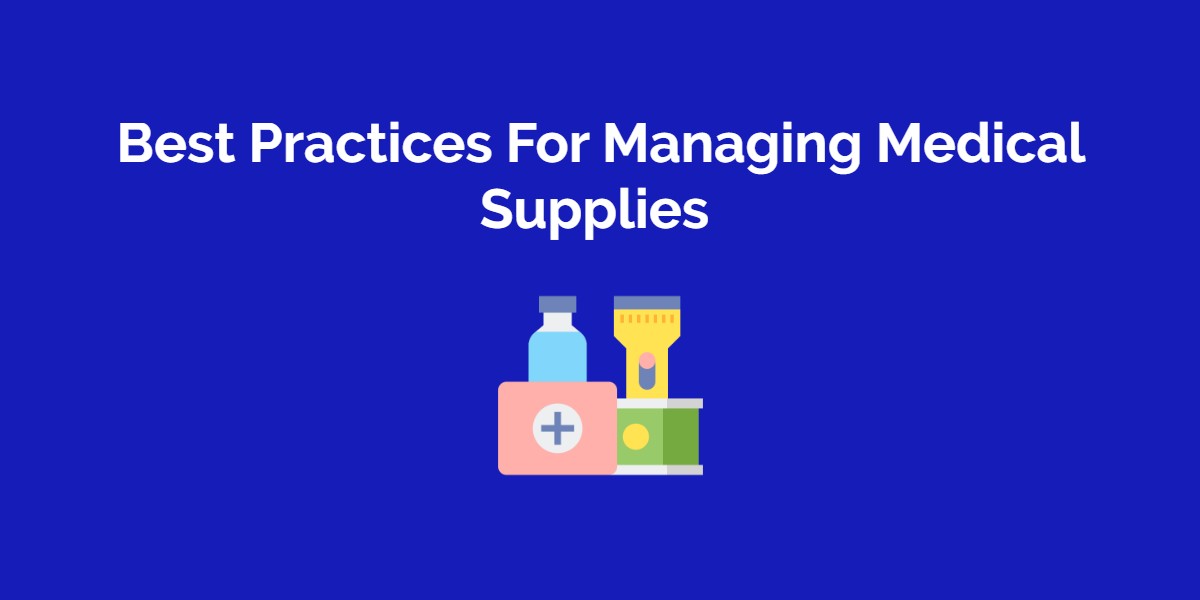What is medical inventory software and why do hospitals need it?
Hospital inventory forms one of the biggest capital investments in the medical industry. Having the right type of tracking tools is the key to successful operations. A slight mishap can lead to unfortunate consequences resulting in legal penalties. Because of this, the healthcare sector is struggling to keep up with the rising costs and demands every year.
Medical institutions deploy a vast range of equipment to carry out daily tasks. If these assets are not properly monitored, it doesn’t only adversely impact organizational efficiency but overburdens the staff as well.
Here are some common inventory challenges faced by the healthcare sector:
- Untimely outage of medicines and surgical equipment
- Overstock of supplies
- Storage and placement of special drugs
- Generating procurement bills
- Creating stock and sales reports
- Disposal of expired medicines in stock
To tackle these issues, hospitals opt for an automated solution package. Such a system helps to streamline inventory management and can benefit the entire team including custodial staff, administrative bodies, and even patients. Inventory software works on the basic principle of tagging all stock items as soon as they are procured. A barcode tag is most commonly used for such practices. This label then enables users to track inventory throughout its lifecycle.
Key aspects of medical supply management
To lower patient safety and liability risks associated with medical supplies, hospitals should implement a robust equipment management program. While doing so, healthcare centers should take into account the expertise of biomedical engineers.

Here are some key aspects of medical inventory control which enable hospitals to raise overall operational efficiency:
A. Inventory documentation
To start off, hospitals should carefully register all types of supplies they have in stock. This includes all major and minor equipment deployed for everyday use and critical operations. Each healthcare organization should follow these steps to achieve a reliable and accurate inventory database:
- Maintain a record of all inventory whether it is leased or owned
- A part of inventory should also include maintenance activities to track usage over time
- Classify every supply stock according to its:
I. Unique identification number II. Manufacturer of the equipment III. Model and serial number IV. Precise description V. Location/storage of the item (in case of fixed locations) VI. Department which owns the medical equipment
B. Evaluation of medical supplies
After having listed down critical information on medical supplies, the next step is to understand how each item can be utilized. One way to do so is to understand and evaluate the functions of hospital equipment by:
- Laying down the basic rules for clinical application
- Establishing the preventative maintenance requirements and expected lifespan
- Estimating the likelihood of equipment failure
- Checking its compatibility with other equipment installed
C. Safety testing
Regular equipment inspection is an essential part of any medical inventory program. Doing so is critical for patient and staff safety. All healthcare centers can implement a basic testing phase for all inventory items:
- Critical equipment like life support and emergency supplies should be tested on a semi-annual basis
- Common use supplies like blood pressure monitors and heat therapy units should be tested on an annual basis
- Low-risk supplies like a patient scale should be visually tested on an annual basis
Hospitals should ensure that only qualified personnel inspect, test and run maintenance for the supplies. A better option is to outsource the services of biomedical technicians for assistance.
D. Staff training
A vital part of medical inventory management is to train staff on how to use different types of hospital tools and devices. Generally, nurses and staff members should be able to report a piece of dysfunctional inventory. In addition to this, it is important to incorporate the use, calibration, and cleanup of hospital supplies in a training session as well. Improper handling of a medical device can lead to serious repercussions for the healthcare center.
Read more: Boost Medical Equipment Safety By Addressing These Common Problems
How does medical inventory software help hospitals?
The majority of healthcare centers struggle with medical supply management. After laying down the basic principles to govern inventory movements, the next step is to develop a centralized database to control it all. For this purpose, hospitals resort to inventory software programs for managing medical supplies. Choosing the right type of medical equipment management software can help a medical organization in the following ways:
1. Saving time through automation
Most of the times, hospitals function in a fast-paced environment and deal with emergency situations. Under such circumstances, the administration can’t forgo the time spent in gathering spreadsheets or following online trails.
Inventory software enables you to speed up the checkout process by tagging all supplies with a unique barcode. This way, the staff can maintain a reliable database and improve processing times. A seamless supply management system lets doctors swift through bottlenecks and eventually, focus on what actually is important – the patients!
2. Improving equipment reliability
All kinds of hospital supplies need to be readily available to serve their function at all times. To ensure this, medical institutions opt for an automated inventory program. This helps biomedical engineers’ structure maintenance and repairs to lower risks of unwanted breakdowns. Regularly serviced equipment increases safety and quality control in hospitals.
3. Compliance with regulations
The medical industry has some strict rules and guidelines which have to be followed. Failure to do so can result in severe penalties and have legal implications. For this purpose, hospitals opt for software which helps them gather accurate inventory information. Having reliable data at hand enables healthcare centers to cross-check any irregularities.
4. Disposal of expired medical supplies
Asset lifecycle management is extremely critical when it comes to medicines and drugs. Mostly because supplying expired items can not only hurt patients but also damage an institution’s credibility. To prevent such mishaps, hospitals run automated depreciation processes. Through these, staff members can track the entire useful life of an asset. Doing so enables pharmacists to monitor and dispose of any expired drugs in a timely manner.
5. Planning for stock replenishment
Due to increasing patient admissions, it is common to run out of high demand supplies. Medical inventory software can help identify spare parts and consumables necessary to keep machines running. This information enables staff members to alert the vendors to avoid an outage. Mainly, the software offers to calculate a usage rate and establish a reorder level that is sufficient to maintain undisrupted services.
Read more: Whitepaper: Executing Healthcare Asset Tracking Workflows
Ten best practices for managing medical supplies

Choosing a suitable software for running hospital operations is just the first step. Next, you have to develop strategies to control asset utilization. Healthcare centers can do this by following ten simple steps to implement robust inventory tracking:
I. Establish procurement cycles: Start off by finding out what level of stock supply is needed to sustain clinical operations. One way to do this for best labor productivity results is to calculate replenishment frequencies for inventory in each area. Apart from this, it also helps to check whether supplies are being restocked more than required. A common practice is to reduce frequencies by resetting the stock levels. This has allowed hospitals to improve labor productivity. Mainly, hospitals should aim to create visibility to determine demand across the organization.
II. Customize according to the workflow: For a successful management policy, biomedical technicians should understand different clinical processes in an area. One strategy cannot fit multiple operations. To cater to numerous types of clinical operations, redesign policies to eliminate redundant steps. A streamlined assembly line lets you ensure optimal supply quantities at all times.
Let’s take a look at the example of the Emergency Department. Here a quick delivery system with fast retrieval is needed. So, the key is to customize supply management according to the workflows.
III. Standardize medical kits: For a hospital to function smoothly, it is important to lay down some quality control principles. When it comes to tagging supplies, technicians should establish a uniform strategy to be followed throughout the healthcare center. For instance, you can either use the locations’, manufacturers’ codes or serial numbers to label your supplies. Working along with this rule, you can easily check out medical kits in cases of emergency. Also, including a guidebook is a good way to help first time users understand the label system.
IV. Determine inventory cycles: All medical supplies have a fixed lifespan and have to be disposed of eventually. But how do healthcare technicians determine the best time to replace old stock? One way to go about this is to record service histories. This data can then be assessed to find out how long a particular supply stock can last. Apart from this, usage history can also help you to figure out what items are cost-effective, currently relevant or safe to use.
By gaining insights into inventory cycles, hospitals can establish disposal and replacement policies.
V. Plan for disaster management: Hospitals should be equipped at all times to tackle any type of emergency situations. Laid down by the World Health Organization, medical centers should have access to therapeutic doses in case a spread of infection. Similarly, when dealing with viral diseases, special care should be taken to maintain cleanliness and dispose of any used instruments. Special attention should be paid to life support and anesthesia supplies as well.
VI. Protect your medical supplies: Medicines and supplies like gauze and surgical tubes should be stored in the correct manner to prevent premature expiration or damage. Most manufacturers of soft medical supplies send items in shipping boxes. Flimsy storage spaces can lead to breakage and even cause contamination of dangerous substances. One way to avoid this is to opt for fragile-labeled, durable, see-through containers. Not only will the supplies stay safe, but they are also easily accessible as well.
VII. Inspect new orders: It is extremely important to check medical supplies as soon as you receive them. Otherwise, you may find out that a piece of equipment is damaged or of poor quality when it needs to be used. By then, it might be too late to ask for a replacement. A good practice is to inspect all spare parts, accessories, manufacturers manual and warranty for all new supplies.
VIII. Design maintenance checklists: The key to keeping all medical supplies and appliances in working condition is to schedule regular maintenance. Start off by preparing a checklist with clear instructions for each piece of equipment. Next, designate responsibilities and set up a system to report defects. Always remember, it is better to consult a specialist for service and repairs. To do so, you can identify authorized technicians for periodic maintenance sessions.
IX. Disinfect medical instruments: Healthcare centers should pay special attention to the sterilization of supplies. A few important things to keep in mind:
- Always sterilize for the correct amount of time. Commonly recommended combinations are 121 degrees for 15 minutes and 134 degrees for 3 minutes
- Never sterilize single-use items. Doing so ends up damaging them
- Carry out sterilization on the day of use, as it is difficult to keep the equipment sterile for a long time
X. Simplify the inventory system: Complex procedures can pile up and make the management process overly tedious. To avoid such occurrences, take out some time to create a simple and user-friendly supply control process. A digital inventory system stores all information on a single platform. This improves collaboration and boosts performance in hospitals.
Conclusion
The key to operational efficacy at the healthcare organizations is to develop a robust medical supply management system. This can be done by understanding the challenges of inventory. To tackle these issues, biomedical technicians can establish a few basic principles to control and monitor equipment utilization. The best way to do so is to adopt an automated system to track inventory.
Opting for a software improves data accuracy by eliminating manual labor and risks involved with human errors. But most importantly, a cloud-based system enables medical institutions to analyze performance. By running inventory reports, staff members can gain insights into which policies are bearing positive outcomes.
About EZOfficeInventory
EZOfficeInventory is the leading medical inventory software that makes managing medical supplies a breeze! You can also track all your machines, conduct audits, ensure compliance, and manage staff users so your equipment is always in top shape and inventory always in optimum level!







